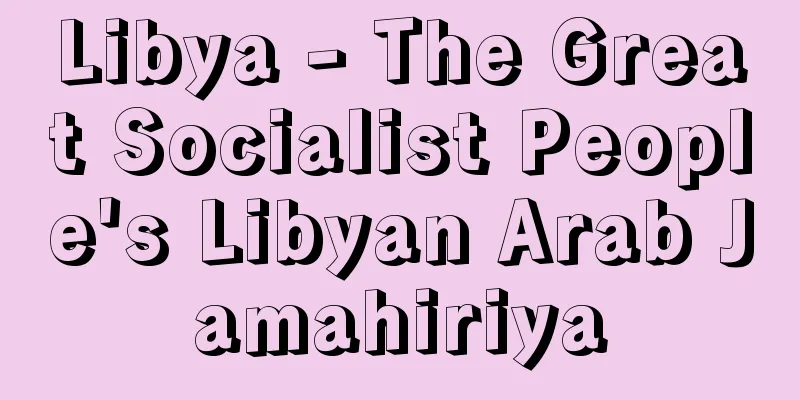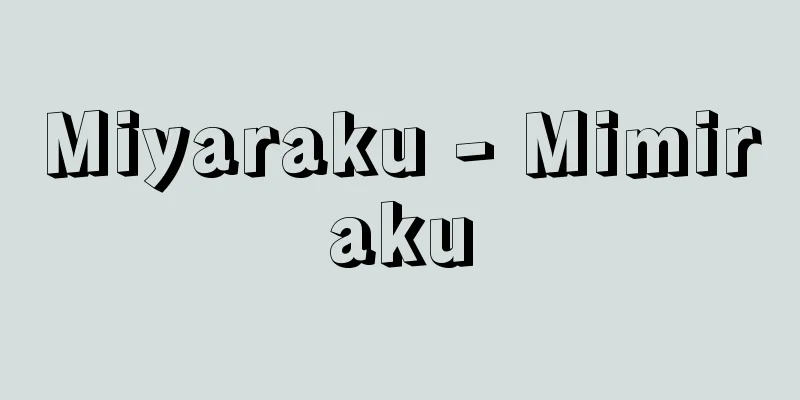Libya - The Great Socialist People's Libyan Arab Jamahiriya

|
A country located in the center of the Mediterranean coast in North Africa. Its official name is the Great Libyan Arab Socialist People's Jamahiriya (al-Jama -hirīya al-'Arabiya al-Lībiya al-Sha'biya al-Ishtirakiya). It borders Egypt and Sudan to the east, Tunisia and Algeria to the west, and Niger and Chad to the south. In the south, the border is unclear in some places, and there are repeated conflicts with Chad. Its land area is 1,759,540 square kilometers, making it the fourth largest country in Africa, but most of it is desert and its population is small, at 5,484,000 (2006 estimate) and 6,420,000 (2009 estimate), with a population density of 3.6 people per square kilometer. It used to be a poor country that relied on irrigated agriculture in the coastal areas and oases and nomadic pastoralism, but oil development since 1955 has transformed it into a wealthy country. Since the Libyan Revolution of 1969, the Gaddafi regime has promoted industrial and agricultural development using its huge oil revenues, and in domestic and foreign affairs has implemented unique policies based on people's direct democracy and pan-Arab nationalism. The capital is Tripoli (population 1.2 million, 2009 estimate). [Hiroshi Fujii] NatureLibya, like its neighboring eastern neighbor Egypt, is made up of vast arid plateaus and lowlands. In general, the plateau in the southern border area is about 1,000 meters above sea level, and gradually drops to the Mediterranean coast, with 70% of the country being plateaus and lowlands below 500 meters above sea level. Deep wadis (dried valleys) such as the Fareg Wadi are carved into the plateau, which are traces of large rivers from the wet period before the Sahara became dry. A coastal plain can be seen along the coast from Tripolitania in the west to the Gulf of Sirte, but east of Benghazi, the Al-Akhdar Mountains face the sea and are lined with cliffs. In the inland desert that occupies most of the country, in addition to low-lying sand dunes, gravel desert and rocky desert are also widely seen. The climate is mostly sunny, with most of the region being covered by the Saharan high pressure throughout the year, and the desert climate has an annual rainfall of less than 100 mm. The only areas that see more than 200 mm of rainfall are the coastal areas of Tripolitania and Cyrenaica, where rain falls in winter due to the influence of Mediterranean low pressure, and the climate is Mediterranean and steppe-like. In terms of temperature, even in the coastal areas of Tripoli and Benghazi, the average temperature in August is hot, at 28°C, and the daytime maximum temperature exceeds 40°C. However, in January the average temperature is quite cool, at 12°C, and snow falls on the plateau behind. Inland, the daily and annual ranges are even larger, with low temperatures at night and often below zero in winter. From late spring to early autumn, a hot wind mixed with sand called the Ghibli blows, which can damage crops. [Hiroshi Fujii] GeographyLibya is roughly divided into three regions: Tripolitania in the northwest, Fezzan in the southwest, and Cyrenaica in the east. These three regions formed a federation immediately after independence as the United Kingdom in 1951. Tripolitania consists of a coastal plain and a plateau behind it. The coastal area is blessed with rainfall in the winter, and has been a supplier of agricultural products since ancient times, known as the "granary of Rome." During the modern Italian colonial period, tens of thousands of immigrants were sent there and operated farms cultivating wheat, fruit, and other crops. It is still the country's largest agricultural region today. It is also home to the capital and largest city, Tripoli, and Misrata, which has a thriving steel industry. Although it accounts for 20% of the country's land area, it is home to 40% of the population. The ancient ruins of Leptis Magna, the ancient ruins of Sabratha, and the old town of Ghadames (Ghadames) are registered as World Heritage sites by UNESCO (United Nations Educational, Scientific and Cultural Organization). Fezzan is part of the Sahara Desert. In addition to Arabs, the region is also inhabited by the Berber Tuareg people, whose livelihoods are oasis agriculture and nomadic pastoralism. The central city of Sebha has long been an important transit point between the Mediterranean Sea and the Sudanese region. The rock art ruins of Tadrat Akaksu are registered as a UNESCO World Heritage Site. Cyrenaica is made up of the Al-Akhdar Mountains along the Mediterranean coast, which is blessed with winter rains, and the Libyan and Sahara Deserts to the south. Traditionally, the only livelihoods were Mediterranean agriculture along the coast, and oasis agriculture and nomadic pastoralism in the inland areas. However, after World War II, oil was developed in the Libyan desert, and Hawaji Governorate has become the center of oil production in the country. There are crude oil shipping ports such as Marsa Hariga and Marsa Brega on the coast, as well as oil refineries. The central city of Benghazi was one of the capitals, along with Tripoli, during the period of the United Kingdom of the Three States immediately after independence. The ancient ruins of Kourina are registered as a UNESCO World Heritage Site. [Hiroshi Fujii] All five of Libya's World Heritage Sites (all cultural heritage sites) were placed on the List of World Heritage in Danger in 2016 due to political instability resulting from the civil war. [Editorial Department, May 21, 2018] historyLibya's history, like that of other North African countries, has been one of responding to domination by countries in the northern and eastern Mediterranean. The region has long been inhabited by the Berbers, but in ancient times the Phoenicians, Greeks, and Romans invaded it one after another, building colonies such as Tripoli and Benghazi along the coast. The grandeur of the cities at that time can be seen in ruins such as Leptis Magna. After that, it passed through the rule of the Vandals and the Byzantine Empire, and in the mid-7th century Arab military expeditions began, and from the late 11th century onwards Arab tribes invaded in large numbers. These tribes also conquered the Berbers inland, and rapidly promoted Arabization and Islamization. The Middle Ages was an era of warring tribes, but the Ottoman Empire began to rule in the mid-16th century. The Ottoman Empire, which took possession of Cyrenaica in 1515, captured Tripoli, which was a Spanish territory, in 1551, taking Tripolitania into its hands, and also brought Fezzan, which had surrendered, under its control. The area of control of the pasha (king) appointed by the empire at that time became the original form of today's Libyan territory. In 1711, a representative of the indigenous Ottoman (Turkish) military took power in place of the pasha and established the Karamanli dynasty in Tripoli. However, in the 19th century, European countries began to advance into North Africa, and the Karamanli dynasty king was forced to abdicate due to interference from France and Britain. In 1835, the Ottoman Empire regained control, but external pressure continued, and the Sanusi sect expanded its influence within the country. In this situation, in 1911, Italy deployed 30,000 troops and modern weapons to occupy the coastal areas. The following year, a ceasefire agreement was signed and the Turkish army withdrew, giving Italy sovereignty over Tripolitania and Cyrenaica. However, resistance in Fezzan, mainly from the Sanusi sect and Berbers, was fierce, and it was not until 1932, 21 years later, that pacification was declared. During World War II, Libya became a battlefield, with Tripolitania and Cyrenaica occupied by the British Army, and Fezzan placed under French military rule. After the war, in 1949, the United Nations General Assembly passed a resolution for Libya's independence, and the 1951 Constitution was adopted based on this, and independence was declared on December 24 of the same year. At the time of independence, Libya was a federal government called the United Kingdom of Libya, and King Idris I, the leader of the Sanusi sect and the head of Cyrenaica, became king. In 1964, the constitution was amended to abolish the federal system, and the country became a unitary state, changing its name to the Kingdom of Libya. However, the parliamentary system did not function well, power was held by the king and a minority, and politics could not respond to the economic development and social changes caused by oil development, which led to growing dissatisfaction among the people. As a result, on September 1, 1969, young officers led by Colonel Gaddafi ousted the king and took power (Libyan Revolution). Gaddafi renamed the country the Libyan Arab Republic, became chairman of the Revolutionary Council, the highest body, and also served as prime minister. After the revolution, Libya promoted Arab nationalism and anti-colonial policies, and in 1973 launched a unique "Cultural Revolution" policy based on Islamic fundamentalism. In 1977, he declared a transition to people's direct democracy, dissolved the Revolutionary Council and the cabinet, and changed the country's name to the Great Libyan Arab Socialist People's Jamahiriya. [Hiroshi Fujii] PoliticsThe political system is a unique socialist system based on direct democracy. In each political unit in the country, there is a Basic People's Assembly (legislative body) in which all adult citizens participate, which elects a Basic People's Committee (executive body). People's assemblies and People's Committees are also organized in each workplace. Members of the Secretariats of the People's Committees of each region and workplace come together to form the General People's Congress (GPC), the country's highest decision-making body, which elects the General People's Committee and the General Secretariat. The highest executive body is the General Secretariat (7 members), and the equivalent of the Cabinet is the General People's Committee (12 members). There are no political parties. In terms of the judiciary, there are courts of first instance in various locations, and the Court of Appeal and the High Court are in Tripoli and Benghazi. Family law matters are handled by religious courts. The civil and criminal codes are strictly based on the Quran, and the death penalty is in place. [Hiroshi Fujii] DiplomacyIn foreign affairs, Libya has taken a hard-line stance against Israel, taking an anti-Zionist and anti-imperialist stance, and has friendly relations with Syria, Iran, Algeria, Russia, and other countries. On the other hand, Libya's relationship with the United States, with which it had previously had a close relationship centered on oil development, has deteriorated due to the United States' aid to Israel. In 1981, a Libyan military plane was shot down by a U.S. military aircraft, and in March 1986, the U.S. Sixth Fleet forced an exercise in the Gulf of Sirte, resulting in a battle. In April of the same year, the U.S. Navy and Air Force bombed Benghazi and Tripoli, and Libya bombed a discotheque in West Berlin. In 1988, a Pan Am plane was bombed over Scotland. Libya was suspected of being involved in the Pan Am plane bombing and the 1989 bombing of a UTA French plane over Niger, and in 1990 the United Nations passed a resolution condemning Libya. Meanwhile, domestically, anti-government forces became more active following a rebellion within the military in 1993. Western countries have accused Libya of being involved in terrorism by anti-government groups around the world. Libya has been isolated from the international community as a "state sponsor of terrorism" and has been subject to long-term economic sanctions. In August 2003, the United Nations froze sanctions after Libya admitted its guilt in the Pan Am bombing and paid compensation to the families of the American victims. In December 2003, Libya announced that it would completely abandon its weapons of mass destruction development program. In March 2004, British Prime Minister Blair visited Libya and met with Colonel Gaddafi, realizing a "historic reconciliation" between Libya, the United Kingdom, and the international community. In August 2008, Italian Prime Minister Berlusconi met with Colonel Gaddafi in Libya, apologized for the oppression during the colonial era, and promised to pay $5 billion in reparations. Colonel Gaddafi announced cooperation with Britain and France in the military, industry, and resource development. The United States lifted sanctions against Libya under the Iran-Libya Sanctions Act in 2004, and removed its designation as a state sponsor of terrorism in 2006. In September 2008, when compensation was completed for both American victims of the West Berlin disco bombing and the Pan Am flight bombing, and for Libyan victims of the retaliatory US airstrikes, Secretary of State Rice visited Libya and met with Colonel Gaddafi, ending the hostilities between the two countries. In October of the same year, the United States opened a trade office in Libya to strengthen economic ties. In terms of relations with African countries, Libya intervened in the civil war in neighboring Chad to the south from 1982 to 1987 over border issues, which drew criticism from member states of the Organization of African Unity (OAU). On the other hand, due to its pan-Arab nationalism and the fact that Libya is a small country, it has attempted to unite with Egypt, Syria, Tunisia, Morocco, and other nations, and has also announced a plan for the creation of the Maghreb Co-Prosperity Sphere consisting of five North African countries. In 2008, Libya mediated a ceasefire agreement between the Mali government and Tuareg rebels. The military consists of 50,000 troops in the army, 8,000 in the navy, and 20,000 in the air force, for a total of 78,000 troops. The military system is a selective conscription system. [Hiroshi Fujii] Economy and IndustryLibya, with most of its land area being arid, was one of the poorest countries in Africa at the time of independence. However, since 1955, oil development has progressed and Libya has become one of the world's leading oil exporters, and the increase in oil revenues has completely transformed the economy. Its per capita gross domestic product (GDP) is $10,074 (2007), the highest in Africa, and oil revenues are being used to develop cities, industry, agriculture, and other areas. In the 1980s, a decline in global oil demand and a drop in oil prices led to a decrease in oil revenues, which delayed the progress of development projects and affected the lives of the people, but the rise in oil prices since the 1990s has once again seen investment from Western countries become active. In 1955, American and British oil companies acquired the rights to explore and develop oil, and in 1959, they succeeded in developing the Zerten oil field, as well as the Amara, Beda, and Dakhla oil fields. From 1960 to 1966, 12 more oil fields were developed, including the Salil oil field. After the revolution, a national oil company was established, and the assets and interests of foreign oil companies were nationalized, and by March 1974, most companies had been nationalized at a rate of 51% or 100%. At this time, all American oil companies were nationalized at 51%, but due to the deterioration of relations with the United States, all of them withdrew from Libya by April 1986. Most of the oil is exported as crude oil. The country's oil fields are concentrated within a 300-kilometer radius of the Gulf of Sirte, which means that the pipelines to the shipping terminals are relatively short, and it is advantageous that it is closer to Europe than Middle Eastern oil fields. It is low in sulfur (sulfur content 0.5%) and light in quality. As of 2007, the proven reserves were 6,593 million kiloliters. Although production has declined significantly compared to the 1970s, annual production is 98,660,000 kiloliters, with a remaining 67 years of recoverable reserves. The proven reserves of natural gas are 4,500 billion cubic meters, with an annual production of 600 million cubic meters. There is a 600-kilometer pipeline to mainland Italy via Sicily. The share of industry in the gross domestic product (GDP) is still only 8% (1990). Tripoli and Benghazi are home to traditional industries such as light industries such as food, textiles, and leather processing. In the heavy chemical industry, Marsa Brega and Misrata have cement, oil refining, petrochemical, steel, and aluminum smelting plants. Agriculture and livestock farming have been practiced in the form of traditional agriculture and livestock farming along the coast, modern agriculture in Italian settlements, nomadic pasture in the interior, and oasis agriculture. However, the arable land area is only about 1.2% of the country, and oil development has caused an outflow of the rural population, making it necessary to import a large amount of food. The government is promoting the expansion of arable land using deep groundwater from the desert, the development of mechanized agriculture, and the promotion of livestock farming, aiming to improve productivity and achieve food self-sufficiency. Major agricultural products include 100,000 tons of wheat, 100,000 tons of barley, 55,000 tons of oranges, 30,000 tons of almonds, 180,000 tons of dates, 190,000 tons of tomatoes, 290,000 tons of potatoes, and 170,000 tons of olives (2006). In the fishing industry, high-quality sponges are collected from the Bay of Sirte and Bomba Bay, and tuna fishing is thriving. In terms of trade, crude oil accounted for 73.8% of total exports, and petroleum products 17.3% (2007). The main export destinations are Italy, Germany, Spain, Turkey, and France, many of which are countries around the Mediterranean Sea. Exports to the United States dropped sharply after the US embargo in 1982. The main import items are machinery, metal products, automobiles, and steel pipes, and the main import destinations are Italy, Germany, Japan, South Korea, the United Kingdom, Turkey, and France. The trade balance has been in surplus since 1962, the year after oil exports began. Domestic transportation is mainly by road and air, with no railways. The main artery of the roads is a highway that runs east-west along the coast, and there are also roads connecting inland oases, oil fields, and borders. Italy is also building a highway as compensation for colonial rule. The passenger car ownership rate is one for every nine people, an exceptional rate for Africa. There are six domestic airports by air, including international airports in Tripoli and Benghazi, Sebha, and Ghadames. A national project is underway to build a large water canal that will pump deep groundwater from beneath the sand dunes and send it to Tripoli and Benghazi through a four-meter diameter pipeline. As of 2007, the second of four phases had been completed, but construction has not yet begun on the third phase, a water supply line to the east toward Tobrok, due to problems with the quantity and quality of the groundwater. [Hiroshi Fujii] Society and CultureThe majority of the population is Arab or a mixture of Arab and Berber, but there are small numbers of Tuareg Berbers in the southwest and mixed Africans in the south. The official language is regular Arabic, with Berber, English and Italian also spoken in some areas. Local Arabic dialects are used in everyday life. The state religion is Islam, with the majority belonging to the Sunni sect, and it is known as one of the strictest countries in the Arab world, although there is also a small number of Catholics. The population growth rate was 2.1% (2000-2008), but the population continues to move away from the countryside to the city, and the urban population ratio is high (77.3% in 2007). Foreign workers also flowed in in large numbers, accounting for 46% of the employed population in 1982. However, due to the subsequent economic downturn, measures to expel Egyptians (100,000) and Tunisians (23,000) were implemented after 1985. In the school system, elementary school is compulsory, followed by middle school, vocational school, and university. There are national universities in Tripoli and Benghazi. Tuition is free from elementary school to university. In terms of medical care, the number of doctors per population is 961 (1988), which is high for Africa, but the infant mortality rate is somewhat high at 17% (2007). The average life expectancy is 74 years for men and 77 years for women. [Hiroshi Fujii] Relations with JapanJapan is providing economic and technical cooperation in the areas of steelworks construction, microwave network construction and other plant construction, oil field development, infrastructure development, development studies, and accepting trainees. In trade, Japan exports steel, machinery and equipment, automobiles, electrical equipment, etc., and imports fish and shellfish, sponge, and rubber scraps, resulting in a large export surplus for Japan. [Hiroshi Fujii] "Libya" by Yuji Oishi (1981, Mizuumi Shoten)" ▽ "Libya" by Yujiro Nishiyama (1982, Japan External Trade Organization)" ▽ "60 Chapters to Understand Libya" by Kazuko Shiojiri (2006, Akashi Shoten) [References] | | | | | | | | | | | | | | | | | | | | | | | | | [Additional resources] |"> Libya flag ©Shogakukan Illustration/Shogakukan Creative "> Libya Location Map The ruins of the ancient Roman city. On the right is the Arch of Trajan. World Heritage Site "Archaeological Site of Leptis Magna" (Libya, registered in 1982) Homs, Libya ©Shogakukan "> The ruins of Leptis Magna Source: Shogakukan Encyclopedia Nipponica About Encyclopedia Nipponica Information | Legend |
|
北アフリカ、地中海岸のほぼ中央にある国。正称は大リビア・アラブ社会主義人民ジャマーヒリーヤ国al-Jama -hirīya al-‘Arabiya al-Lībiya al-Sha‘biya al-Ishtirakiya。東はエジプト、スーダンと、西はチュニジア、アルジェリアと、南はニジェール、チャドと国境を接する。南部では国境線が未確定な所があり、チャドと紛争を繰り返している。国土面積は175万9540平方キロメートルでアフリカ4番目の大国だが、大部分は砂漠地帯で人口は548万4000(2006推計)、642万(2009推計)と少なく、人口密度は1平方キロメートル当り3.6人。かつては海岸地帯やオアシスでの灌漑(かんがい)農業と遊牧に依存する貧しい国であったが、1955年以降の石油開発により富裕国に一変した。1969年のリビア革命以降、カダフィ政権は膨大な石油収入をもとに工業・農業開発を進め、内政、外交では人民直接民主主義と汎(はん)アラブ民族主義に基づいた独特な政策を展開している。首都はトリポリ(人口120万。2009推計)。 [藤井宏志] 自然リビアは、東隣のエジプトと同じく、全体が広大な乾燥した高原と低地からなる。全般に南部国境地域の標高1000メートル前後の高原から、地中海沿岸へとしだいに低くなり、国土の70%が500メートル以下の高原や低地である。高原にはファレグ・ワジのような深いワジ(涸(か)れ谷)が刻まれているが、これはサハラの乾燥化以前の湿潤期の大河の跡である。沿岸は西のトリポリタニアからシルテ湾にかけては海岸平野がみられるが、ベンガジより東では、アフダル山脈が海に臨み、断崖(だんがい)が続いている。大部分を占める内陸の砂漠では、低所の砂丘群のほか、礫(れき)砂漠、岩石砂漠も広くみられる。 気候は年間を通じてサハラの高気圧に覆われるため、晴天が多く、大部分の地域が年降水量100ミリメートル未満の砂漠気候である。200ミリメートル以上の降雨をみるのは、トリポリタニア、キレナイカの突出した沿岸地域のみで、冬季に地中海低気圧の影響で雨が降り、地中海性、ステップ気候を示す。気温は、沿岸のトリポリ、ベンガジでも8月の平均気温が28℃と暑く、日中の最高気温は40℃を超える。しかし1月の平均気温は12℃とかなり涼しくなり、背後の高原では降雪をみる。内陸では日較差、年較差ともさらに大きく、夜間は低温となり、冬は零下気温になることも多い。なお晩春から初秋にかけ、ジブリとよばれる砂まじりの熱風が吹き、農作物が被害を受けることがある。 [藤井宏志] 地誌リビアは北西部のトリポリタニア、南西部のフェザン、東部のキレナイカの3地方に大別される。この3地方は1951年連合王国として独立直後、連邦を構成した3州である。トリポリタニアは海岸平野と背後の高原とからなる。沿岸部は冬に降雨に恵まれ、古代から「ローマの穀倉」とよばれる農産物の供給地であった。近代のイタリア植民地時代には数万人の移民が送り込まれ、小麦、果樹などを栽培する農園を経営した。現在でもこの国第一の農業地帯である。また首都で最大都市のトリポリ、鉄鋼工業の盛んなミスラータがあり、面積は国土の20%だが人口の40%が集中する。レプティス・マグナの古代遺跡、サブラータの古代遺跡、ガダメス(ガダーミス)の旧市街がユネスコ(国連教育科学文化機関)の世界遺産に登録されている。フェザンはサハラ砂漠の一部をなす。アラブ人のほかベルベル系のトゥアレグ人も居住し、オアシス農業と遊牧が生業である。中心地のセブハは、古くから地中海とスーダン地帯を結ぶ重要な中継点であった。タドラット・アカクスのロック・アート遺跡群がユネスコの世界遺産に登録されている。キレナイカは、冬雨に恵まれる地中海沿岸のアフダル山脈と南のリビア砂漠、サハラ砂漠よりなる。従来、生業は沿岸部では地中海式農業、内陸部ではオアシス農業と遊牧が行われるだけであった。しかし第二次世界大戦後リビア砂漠で石油が開発され、ハワジ県は同国の石油生産の中心地になっている。沿岸にはマルサ・ハリガ、マルサ・ブレガなどの原油積出し港のほか製油所もある。なお中心都市のベンガジは独立直後の3州連合王国時代、トリポリとともに首都の一つであった。クーリナの古代遺跡がユネスコの世界遺産に登録されている。 [藤井宏志] なお、リビアにある5件の世界遺産(すべて文化遺産)は、内戦に伴う政情不安などにより、2016年にすべてが危機遺産リスト入りした。 [編集部 2018年5月21日] 歴史リビアの歴史は、他の北アフリカ諸国と同じく、地中海北部および東部諸国による支配への対応の歴史であった。この地域は古くからベルベル人が住んでいたが、古代にフェニキア、ギリシア、ローマが次々に侵入し、沿岸にトリポリ、ベンガジなどの植民都市を建設した。当時の都市の壮大さはレプティス・マグナなどの遺跡にしのぶことができる。その後、バンダル人、ビザンティン帝国の支配を経て、7世紀なかばにはアラブ人の軍事遠征が始まり、11世紀後半以降アラブ諸部族が大挙して侵入した。これら諸部族は内陸のベルベル人をも制圧し、アラブ化、イスラム(イスラーム)化を急速に進めた。 中世は部族単位の群雄割拠の時代であったが、16世紀なかばからオスマン帝国による支配が始まった。1515年キレナイカを領有したオスマン帝国は、1551年スペイン領であったトリポリを攻略してトリポリタニアも掌中に収め、帰順したフェザンをも支配下に置いた。当時帝国が任命したパシャ(王)の支配範囲が今日のリビアの版図の原形となっている。1711年にはパシャにかわって土着化したオスマン帝国(トルコ)軍人の代表が実権を握り、トリポリにカラマンリー朝を建てた。しかし19世紀になるとヨーロッパ諸国の北アフリカ進出が始まり、フランスとイギリスの干渉でカラマンリー朝の王は退位に追い込まれた。1835年オスマン帝国による支配は回復されたものの外圧は続き、国内ではサヌーシー教団が勢力を拡大した。こうしたなかで1911年イタリアは3万の兵力と近代兵器を投入して沿岸部を占領した。翌年停戦協定でトルコ軍が撤退し、イタリアがトリポリタニアとキレナイカの主権を得た。しかしフェザンではサヌーシー教団やベルベル人を主体とする抵抗が激しく、平定が宣言されたのは21年後の1932年であった。 第二次世界大戦中リビアは戦場となり、トリポリタニア、キレナイカはイギリス軍に占領され、フェザンはフランスの軍政下に置かれた。戦後の1949年、国連総会はリビアの独立を決議し、これに基づき1951年憲法が採択され、同年12月24日独立を宣言した。独立時のリビアの政体は連邦制でありリビア連合王国と称し、国王にはキレナイカの首長でありサヌーシー教団の指導者イドリース1世が就任した。1964年に憲法を改正して連邦制を廃止し、単一国家となりリビア王国と改称した。しかし議会制度がうまく機能せず、権力が王と少数者に握られ、また石油開発による経済発展、社会変動に政治が対応できず、国民に不満が高まった。その結果1969年9月1日、カダフィ大佐を中心とする青年将校が国王を追放し政権を握った(リビア革命)。カダフィは国名をリビア・アラブ共和国とし、最高機関の革命評議会の議長に就任し、首相も兼任した。革命後のリビアはアラブ民族主義、反植民地主義の政策を推し進め、1973年イスラム本源主義の立場からの独特の「文化革命」政策を打ち出した。さらに1977年人民直接民主主義への移行を宣言し、革命評議会や内閣は解散し、国名も大リビア・アラブ社会主義人民ジャマーヒリーヤ国に変更した。 [藤井宏志] 政治政体は特異な直接民主制による社会主義国で、全国各地域の政治単位に全成人人民が参加する基本人民会議(立法機関)があり、これが基本人民委員会(行政機関)を選出する。各職場でも人民会議、人民委員会を組織する。各地域、各職場の人民委員会書記局メンバーが集まり国の最高意思決定機関である全人民会議(GPC)を構成し、これが全人民委員会と総書記局を選出する。最高執行機関は総書記局(7名)で、内閣に相当するのは全人民委員会(12名)である。政党はない。司法は、初審裁判所が各所にあり、控訴裁判所、高等裁判所はトリポリ、ベンガジにある。家族法に関することは宗教裁判所が取り扱う。民法、刑法は厳密にコーランに基づいてつくられており、死刑制度がある。 [藤井宏志] 外交外交では反シオニズム、反帝国主義の立場から、対イスラエル強硬路線をとり、シリア、イラン、アルジェリア、ロシアなどとは友好関係にある。逆に、従来石油開発を中心に密接な関係にあったアメリカとは、アメリカのイスラエルへの援助を理由に関係が悪化していた。1981年にはアメリカ軍機のリビア軍機撃墜事件が起こり、1986年3月にはシルテ湾でのアメリカ第六艦隊の演習強行による交戦、同年4月にはアメリカ海・空軍によるベンガジ、トリポリ爆撃事件、リビアによる西ベルリンでのディスコ爆破事件が起き、1988年にはスコットランド上空でのパンナム機爆破事件などが起きた。パンナム機爆破事件および1989年のニジェール上空でのUTAフランス機爆破の二つの事件にリビアの関与が疑われ、1990年国連でリビアに対する非難決議が採択された。一方、国内では1993年に起きた軍内部での反乱事件をきっかけに、反政府勢力の活動が活発化した。 西欧諸国はリビアが世界各地の反体制グループのテロなどに関与していると非難。リビアは「テロ支援国家」として国際社会から孤立し、長期にわたる経済制裁を受けた。2003年8月、パンナム機爆破事件で、リビア側が非を認めてアメリカ人被害者遺族に賠償金を支払ったことから国連は制裁を凍結した。2003年12月にリビアは大量破壊兵器開発計画の完全廃棄を表明。2004年3月にはイギリスの首相ブレアがリビアを訪問しカダフィ大佐と会談、リビアとイギリスおよび国際社会との「歴史的和解」が実現した。また、イタリアの首相ベルルスコーニは2008年8月、リビアでカダフィ大佐と会談し、植民地時代の抑圧をわび、賠償として50億ドルを支出することを約した。カダフィ大佐はイギリス、フランスと軍事、産業、資源開発での協力を表明した。 アメリカは2004年にイラン・リビア制裁法によるリビアへの制裁を解除、2006年にリビアに対するテロ支援国家指定を解除した。西ベルリンでのディスコ爆発事件、パンナム機爆破事件でのアメリカ側被害者およびアメリカ軍の報復空爆によるリビア側被害者への双方の補償が完了した2008年9月、国務長官ライスがリビアを訪問してカダフィ大佐と会談し両国の対立関係は終わった。同年10月、アメリカは経済関係強化に向けリビアに貿易事務所を開設した。 アフリカ諸国との関係では、南の隣国チャドの内戦に1982~1987年国境問題を理由に介入し、アフリカ統一機構(OAU)加盟国から非難された。一方、汎(はん)アラブ民族主義とリビアが小国という条件から、これまでエジプト、シリア、チュニジア、モロッコなどとの合邦を試み、北アフリカ5か国によるマグレブ共栄圏の構想も発表している。2008年にはマリ政府とトゥアレグ反政府勢力との停戦協定の仲介を行った。 なお、軍隊は陸軍5万人、海軍8000人、空軍2万人で、総兵力7万8000人である。兵制は選抜徴兵制である。 [藤井宏志] 経済・産業国土のほとんどが乾燥地域であるリビアは、独立当時はアフリカでももっとも貧しい国の一つであった。しかし、1955年以降石油開発が進んで世界有数の石油輸出国となり、石油収入の増大により経済は一変した。1人当り国内総生産(GDP)は1万0074ドル(2007)とアフリカ大陸第一で、石油収入をもとに都市、工業、農業などの開発が進められている。1980年代は世界的な石油需要の減退と価格低落によって石油収入が減少し、開発事業の進捗(しんちょく)が遅れ、国民生活も影響を受けていたが、1990年代以降の石油価格高騰によりふたたび欧米諸国の投資は活発化している。 石油は、1955年アメリカ系、イギリス系の石油資本が利権を取得して探査、開発を進め、1959年、ゼルテン油田をはじめとして、アマーラ、ベダ、ダフラの各油田の開発が成功した。その後、1960~1966年にもサリル油田をはじめ12油田が次々に開発された。革命後は国営石油会社が設立され、外国石油会社の資産、権益の国有化が進められ、1974年3月までにほとんどの会社について51%あるいは100%の率で国有化を達成した。このとき51%の国有化にとどまっていたのはいずれもアメリカ系石油会社であったが、対米関係の悪化から1986年4月までに全社がリビアから撤退した。石油は大部分が原油のまま輸出される。同国の油田はシルテ湾から300キロメートルの範囲に集中しており、積出し基地までのパイプラインが比較的短くてすみ、また中東の油田よりヨーロッパに近いことが有利である。品質も低硫黄(いおう)(硫黄含有率0.5%)、軽質という特性をもつ。2007年現在の確認埋蔵量は65億9300万キロリットル。1970年代に比べ大幅に減産中であるが、年生産量は9866万キロリットルで、可採年数はあと67年である。また天然ガスも確認埋蔵量4兆5000億立方メートルで年間6億立方メートル生産される。シチリア島経由でイタリア本土へ600キロメートルのパイプラインがある。 工業が国内総生産(GDP)に占める割合は、まだ8%(1990)である。トリポリとベンガジには、食品などの軽工業や織物、皮革加工など伝統工業が集中している。重化学工業では、マルサ・ブレガやミスラータなどにセメント、石油精製、石油科学、鉄鋼、アルミニウム精錬などの工場がある。 農牧業は沿岸部の伝統的農牧業、イタリア人入植地の近代的農業、内陸部の遊牧、オアシス農業という形態で行われてきた。しかし耕作可能面積が国土の1.2%ほどであるうえ、石油開発により農村人口の流出が生じ、かなりの食料品の輸入が不可欠となっている。政府は砂漠の深層地下水などを利用した耕地の拡大と機械化農業の開発、畜産の振興を進め、生産性向上と食料自給を目ざしている。主要農産物としては小麦10万トン、大麦10万トン、オレンジ5万5000トン、アーモンド3万トン、ナツメヤシ18万トン、トマト19万トン、ジャガイモ29万トン、オリーブ17万トンなど(2006)がある。漁業は、高品質の海綿がシルテ湾、ボンバ湾で採取されるほか、マグロ漁が盛んである。 貿易は、輸出では原油が総輸出額の73.8%、石油製品が17.3%(2007)を占める。おもな輸出相手国はイタリア、ドイツ、スペイン、トルコ、フランスで地中海周辺国が多い。アメリカへの輸出は1982年以降アメリカの禁輸措置で激減した。輸入は機械類、金属製品、自動車、鋼管が主要品目で、おもな輸入相手国は、イタリア、ドイツ、日本、韓国、イギリス、トルコ、フランスである。貿易収支は石油の輸出が始まった翌年の1962年以降、黒字が続いている。 国内交通は、鉄道はなく、道路と空路が中心である。道路は沿岸を東西に貫くハイウェーを大動脈とし、内陸のオアシス、油田、国境を結ぶ道路も整備されている。このほか、イタリアが植民地支配の賠償として高速道路を建設中である。乗用車保有率は9人に1台とアフリカでは抜群の普及率を示す。空路はトリポリ、ベンガジの国際空港のほか、セブハ、ガダメスなど六つの国内空港がある。国家的事業として砂丘の地下の深層地下水をくみ上げ、直径4メートルのパイプラインでトリポリ、ベンガジへ送る大用水運河計画が行われており、2007年時点で、4期のうち第二期までが完成しているが、第三期の東方のトブロク方面への給水ラインは地下水の量と質に問題があり、着工されていない。 [藤井宏志] 社会・文化国民の大部分はアラブ人、あるいはアラブ人とベルベル人の混血だが、南西部にはベルベル系トゥアレグ人、南部にはアフリカ系住民との混血も少数いる。公用語は正則アラビア語であり、ベルベル語、英語、イタリア語も一部で用いられる。一般生活にはアラビア語地方方言が使われている。宗教はイスラム教(イスラーム)が国教で大部分がスンニー派に属し、アラブ世界でも、もっとも戒律の厳しい国として知られるが、カトリック教徒も少数いる。 人口増加率は2.1%(2000~2008)であるが、離村向都が続いており、都市人口比率は高い(77.3%。2007)。外国人労働者も多数流入し、1982年には就業者の46%を占めた。しかしその後の経済悪化から、1985年以降エジプト人(10万)、チュニジア人(2万3000)などの追放策を断行した。学校制度は、小学校が義務教育で、中学校あるいは実業学校、大学へと進む。大学はトリポリとベンガジに国立大学がある。授業料は小学校から大学まで無料である。医療では、医師1人当り人口は961人(1988)とアフリカでは医師の数は多いが、乳児死亡率は17%(2007)とやや高い。平均寿命は男74歳、女77歳である。 [藤井宏志] 日本との関係日本は製鉄所建設、マイクロウェーブ網整備などのプラント建設、油田開発、インフラストラクチュア(経済基盤)整備、開発調査、研修員受け入れの面で経済技術協力を行っている。貿易では、日本は鉄鋼、機械機器、自動車、電気機器などを輸出し、魚貝類、海綿、ゴムのくずを輸入しており、日本の大幅な輸出超過である。 [藤井宏志] 『大石悠二著『リビア』(1981・みずうみ書店)』▽『西山雄二郎著『リビア』(1982・日本貿易振興会)』▽『塩尻和子著『リビアを知るための60章』(2006・明石書店)』 [参照項目] | | | | | | | | | | | | | | | | | | | | | | | | | [補完資料] |"> リビアの国旗 ©Shogakukan 作図/小学館クリエイティブ"> リビア位置図 ローマ時代の古代都市遺跡。右はトラヤヌス皇帝記念門。世界文化遺産「レプティス・マグナの古代遺跡」(リビア・1982年登録) リビア ホムス©Shogakukan"> レプティス・マグナの遺跡 出典 小学館 日本大百科全書(ニッポニカ)日本大百科全書(ニッポニカ)について 情報 | 凡例 |
<<: Libyan Desert - Libyan Desert
>>: Libby - Willard Frank Libby
Recommend
Emperor Xuan
91 to 49 China, former Han Emperor Liu Xun of the ...
Gaigo - Gaigo
When viewed from Earth, an inner planet is in the ...
Lethrinus haematopterus (English spelling)
A marine fish of the family Ophiopogonidae in the ...
Huan Xuan (English spelling)
369‐404 A Chinese politician from the end of the E...
Aloha State
The islands, blessed with a mild climate all year...
Engishiki
This is one of the Sandai Kakushiki (Three Imperia...
Public Health - Public Health
Public health refers to organized social activiti...
L-Glycerol-3-phosphate - L-Glycerol-3-phosphate
…Glycerol, along with glucose, plays an important...
Yuzuki-kun - Yuzuki-kun
A legendary figure who is said to be the leader of...
Electrowinning - Denkaisaishu
A smelting process in which heavy metals are extra...
Balkh (English spelling)
A town in Balkh Province in north-central Afghanis...
Motor neurone disease (amyotrophic lateral sclerosis)
What is the disease? Progressive neurodegenerativ...
Anshi Rebellion
The rebellion by An Lushan and Shi Siming (755-76...
synthétisme (English spelling)
...The colors were divided into simple but solid ...
Erysiphaceae
…Sulfur agents are a good pest control agent. [Te...







![Iguchi [village] - Inokuchi](/upload/images/67caf0b5d1edb.webp)

